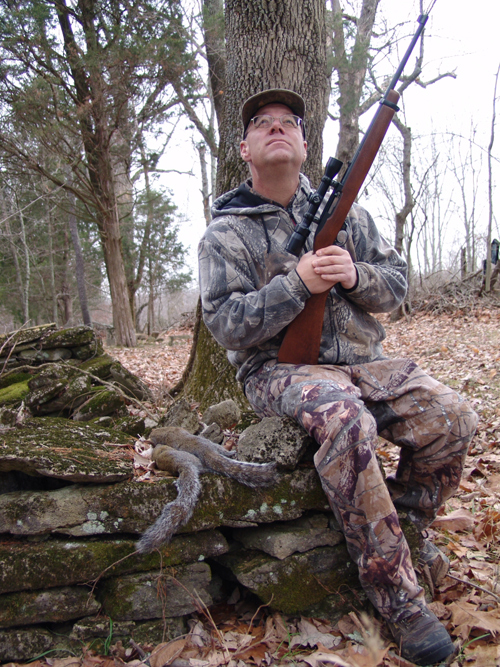BY Kevin Kelly
FRANKFORT, Ky. – Generations of hunters have honed basic hunting skills and techniques and provided tasty table fare by stalking the forest for squirrels.
For a young Chris Garland, squirrel hunting provided a gateway into the woods and remains a family tradition.
“I still enjoy it,” said Garland, now an assistant director in the Kentucky Department of Fish and Wildlife Resources’ wildlife division. “Opening weekend comes and I almost feel obligated to go. I’ll go a little bit in the early season and I like to go after deer gun season. That’s another fun time to hunt because there is a little less pressure on other species and fewer people in the woods, especially on public lands.”
Kentucky’s fall squirrel season opens Aug. 16 and continues through Nov. 7. It resumes Nov. 10 following a pause for the opening weekend of modern gun deer season and ends Feb. 28.
The outlook is encouraging.
“I think we’ll have another good season,” said Ben Robinson, small game biologist with Kentucky Fish and Wildlife. “We’ve been trending up for a little while. The squirrel population is in really good shape right now.”
Hunters help Kentucky Fish and Wildlife monitor the squirrel population by volunteering for the annual Squirrel Hunter Cooperator Survey.
Last year, data provided by 81 hunter cooperators showed they saw an average of two squirrels per hour and hunted for an average of three hours. Dogs were used on 5.6 percent of squirrel hunts.
Biologists expect more of the same this season.
The fall mast crop plays a considerable role in squirrel populations. Following a good mast year, squirrels typically enter spring and summer in better physical condition and female squirrels tend to produce healthier litters.
“Fortunately we had a pretty good mast year last year,” Robinson said.
As children, many of us were taught to stop, look and listen before crossing a roadway or railroad tracks.
The concept also applies to squirrel hunting during the early fall season when trees are still full of leaves and the dense foliage can conceal squirrels from a hunter’s sight. That’s why a lot of people prefer to use a shotgun in the early season.
Look for stands of hickory, oak and beech trees. Freshly cut nuts falling from above or shavings piled around the base of a tree are tell-tale signs of a good place to set up. Soft mast like dogwood berries and black gum fruit also is an important food source for squirrels in the early fall. As the season wears on, there’s a variety of hard mast available, particularly acorns.
“Even if it’s kind of dry, usually there’s enough dew on the ground in the morning that you can sneak around without making a whole lot of noise,” Garland said. “You can hear them cutting and barking or just see the movement in the tree limbs. If it’s a really foggy morning or it’s rained recently, when they jump from limb to limb, you can hear the water hitting the forest floor.”
Setting up in the early morning or at dusk are good bets. Squirrels are most active during those periods.
“Be patient. Wait for noise. See the treetops moving. See the leaves bouncing around,” Robinson said.
Novices may find squirrel hunting to their liking because it doesn’t require an abundance of equipment or gear to get started.
A 20-gauge or smaller shotgun is preferred by many for early squirrel season while a .22-caliber rifle is a late season staple once the leaves have fallen. Some comfortable camouflage clothing, a grippy pair of boots along with bug spray, and you’re all but set for an early season outing.
“It’s nice time to get out and a good way to introduce kids to firearms because you don’t need a high-powered rifle,” Robinson said. “You can take a .22 or a .410 out and get kids oriented to firearms and hunter safety. And if you’re using dogs, you’re up walking and moving. You’re not going to be bored. There’s a lot to look at and a lot to do.”
Hunters are allowed six squirrels per day, with a possession limit of 12 squirrels. Consult the 2014-2015 Kentucky Hunting and Trapping Guide for additional information about squirrel hunting.
Fall Squirrel Hunter Cooperator Survey logs are available by calling Kentucky Fish and Wildlife at 1-800-858-1549 or online at fw.ky.gov. Click on the “Hunt” tab, select “Game Species” from the dropdown menu and click “Squirrel.” Each year, hunting log cooperators receive an annual report and a small gift for their participation.
Kevin Kelly is a staff writer for Kentucky Afield magazine, the official publication of the Kentucky Department of Fish and Wildlife Resources. He is an avid angler with a passion for muskellunge and stream fishing. Get the latest from Kevin and the entire Kentucky Afield staff by following them on Twitter: @kyafield.
-30-
The Kentucky Department of Fish and Wildlife Resources manages, regulates, enforces and promotes responsible use of all fish and wildlife species, their habitats, public wildlife areas and waterways for the benefit of those resources and for public enjoyment. Kentucky Fish and Wildlife is an agency of the Tourism, Arts and Heritage Cabinet. For more information on the department, visit our website at fw.ky.gov.


Be the first to comment